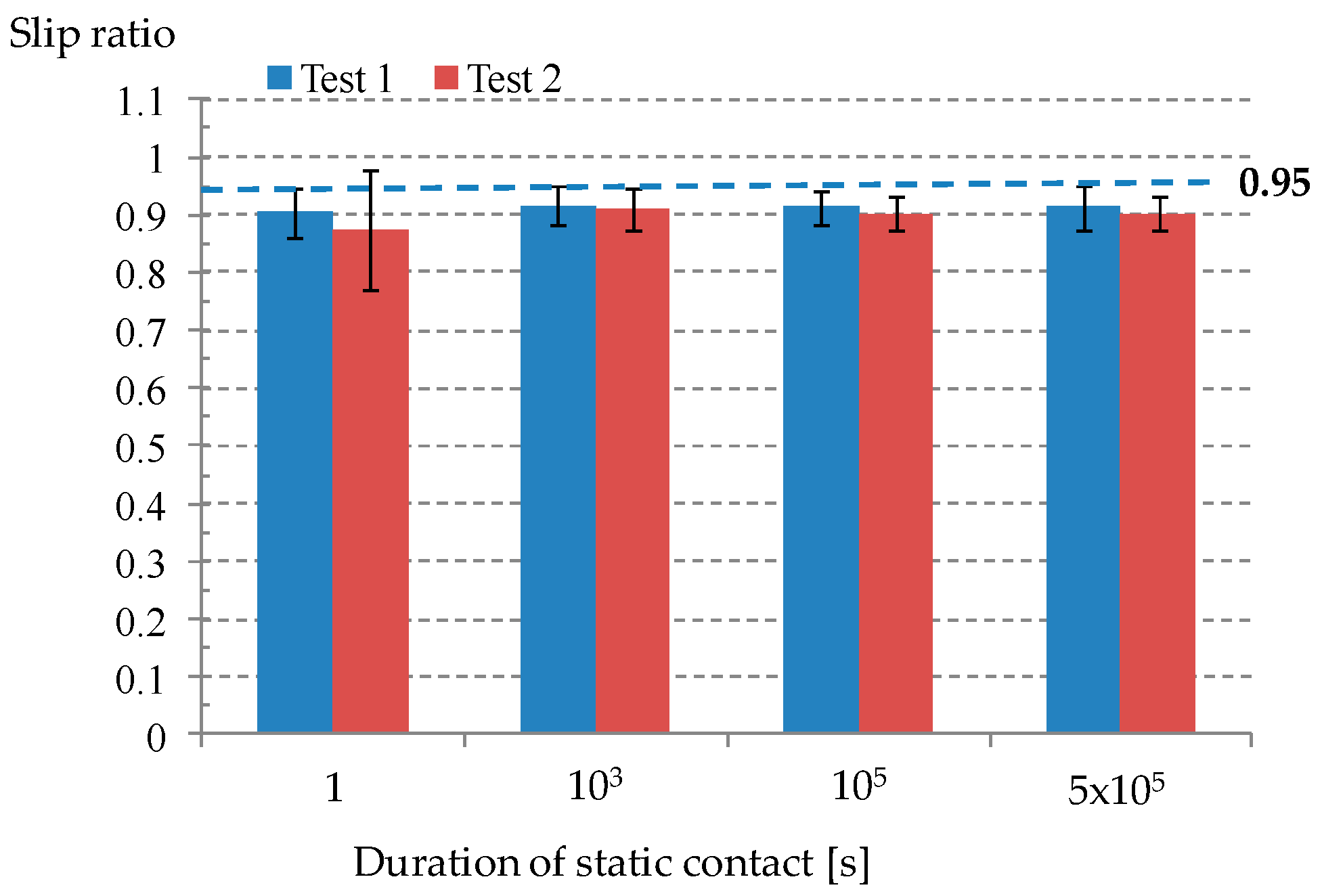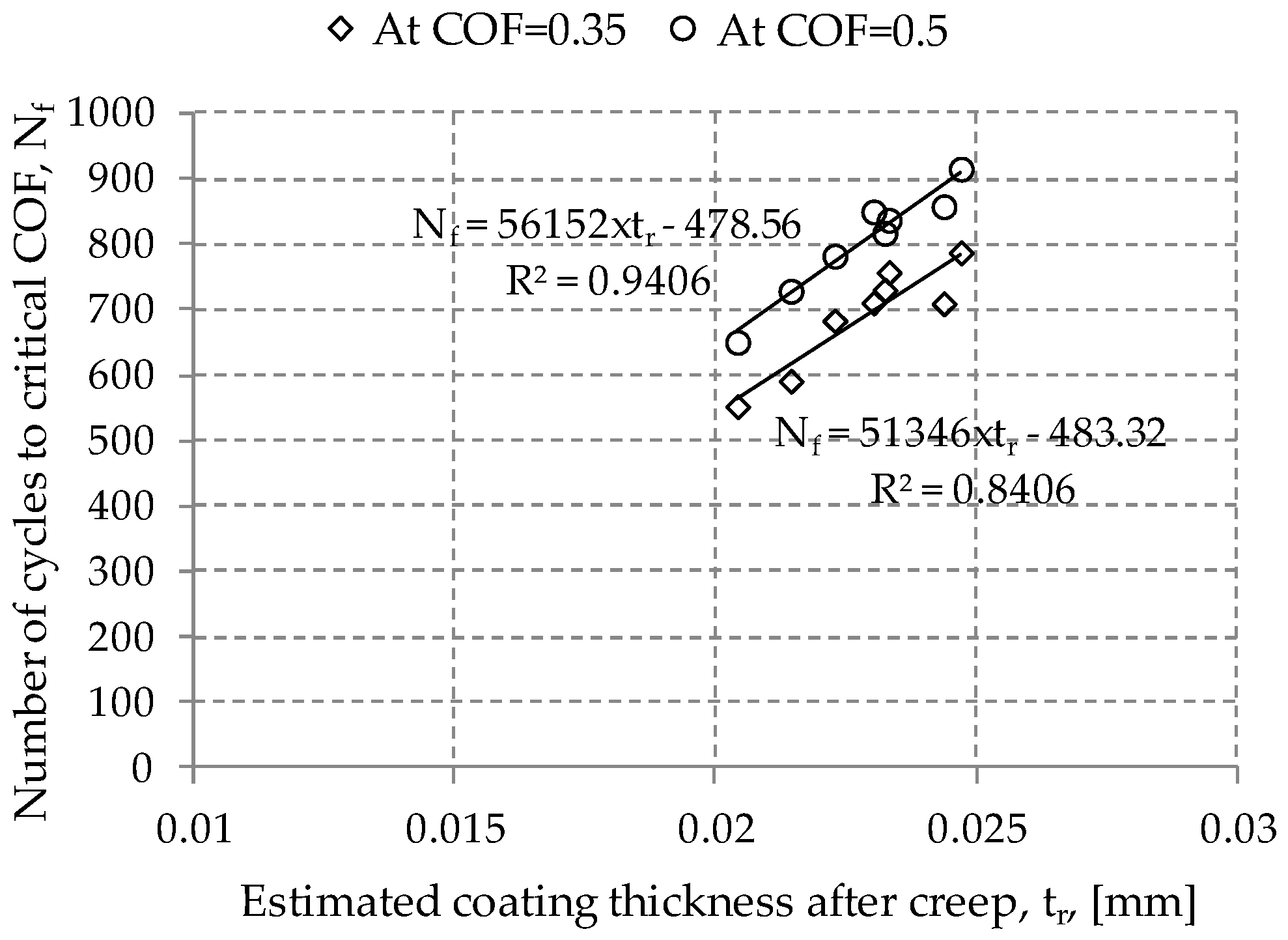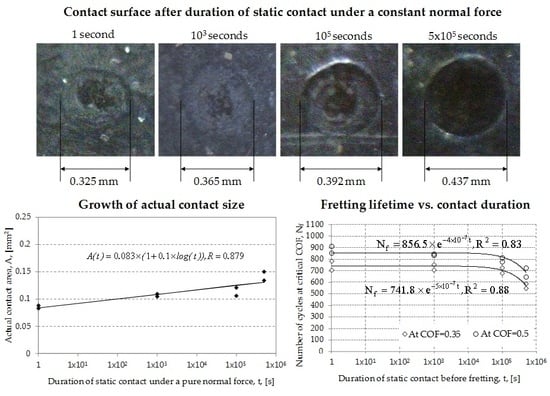The Contact Ageing Effect on Fretting Damage of an Electro-Deposited Coating against an AISI52100 Steel Ball
Abstract
:1. Introduction
2. Experimental Set-Up
2.1. Fretting Test Rig
2.2. Test Material and Test Condition
3. Results and Discussion
3.1. Determination of Plastically Deformed Contact Region
3.2. Fretting Wear Test Results
4. Conclusions
- Frictional contact between an AISI52100 ball and an electro-deposited coating led to plastic deformation on an electro-deposited coating under pure normal force. Spherical indentation was found to remain on the coating after unloading. The plastically deformed contact region increased with the increased duration of static contact under a constant normal force. An actual contact area was found to be expressed as a logarithmic function.
- Fretting test results with various durations of static contact before fretting showed that the kinetic friction coefficient values at the initial and steady-state sliding stages were not affected by the duration of static contact before fretting.
- Number of fretting cycles to the critical friction coefficient (i.e. 0.35 and 0.5) was found to decrease with the increased duration of static contact before fretting. It can be concluded that creep of an electro-deposited coating leads to degradation of fretting resistance of an electro-deposited coating.
Acknowledgments
Author Contributions
Conflicts of Interest
References
- Dieterich, J.H.; Kilgore, B.D. Direct observation of frictional contacts: New insights for state-dependent properties. Pure Appl. Geophys. 1996, 143, 283–302. [Google Scholar] [CrossRef]
- Bhushan, B. Introduction to Tribology; John Wiley & Sons: New York, NY, USA, 2002. [Google Scholar]
- Scholz, C.H.; Engelder, J.T. The role of asperity indentation and ploughing in rock friction–I: Asperity creep and stick-slip. Int. J. Rock Mech. Min. Sci. Geomech. Abstr. 1976, 13, 149–154. [Google Scholar] [CrossRef]
- Li, Q.; Tullis, T.E.; Goldsby, D.; Carpick, R.W. Frictional ageing from interfacial bonding and the origins of rate and state friction. Nature 2011, 480, 233–236. [Google Scholar] [CrossRef] [PubMed]
- Baumberger, T.; Caroli, C. Solid friction from stick-slip down to pinning and aging. Adv. Phys. 2006, 55, 279–348. [Google Scholar] [CrossRef]
- Dieterich, J.H. Time-dependent friction in rocks. J. Geophys. Res. 1972, 77, 3690–3697. [Google Scholar] [CrossRef]
- Waterhouse, R.B. Fretting Corrosion; Pergamon Press: London, UK, 1972. [Google Scholar]
- Watabe, T.; Amanov, A.; Tsuboi, R.; Sasaki, S. Friction and fretting wear characteristics of different diamond-like carbon coatings against alumina in water-lubricated fretting conditions. J. Nanosci. Nanotechnol. 2013, 13, 8167–8175. [Google Scholar] [CrossRef] [PubMed]
- Kim, K.; Korsunsky, A.M. Fretting damage of Ni-MoS2 coatings: Friction coefficient and accumulated dissipated energy evolutions. Proc. Inst. Mech. Eng. Part J J. Eng. Tribol. 2010, 11, 1173–1180. [Google Scholar] [CrossRef]
- Fettis, G. (Ed.) Automotive Paints and Coatings; VCH: Weinheim, Germany, 1995.
- Kim, K. A study on the frictional characteristics of metal and ceramic counterfaces against electro-deposited coatings for use on automotive seat rails. Wear 2014, 320, 62–67. [Google Scholar] [CrossRef]
- Vleeshouwers, S.; Jamieson, A.M.; Simha, R. Effect of physical aging on tensile stress relaxation and tensile creep of cured EPON 828/epoxy adhesives in the linear viscoelastic region. Polym. Eng. Sci. 1989, 29, 662–670. [Google Scholar] [CrossRef]
- Lee, J.K.; Pae, K.D. Creep behavior of an epoxy resin cured under hydrostatic pressure. J. Macromol. Sci. B 1997, 36, 475–485. [Google Scholar] [CrossRef]
- Kim, K. Evaluation and description of friction between an electro-deposited coating and a ceramic ball under fretting condition. Materials 2015, 8, 4778–4789. [Google Scholar] [CrossRef]
- Hur, J.W.; Baek, S.Y.; Kim, K. Effect of displacement on kinetic frictional behavior between electro-deposited coating and AISI 52100 steel under fretting conditions. Proc. Inst. Mech. Eng. Part J J. Eng. Tribol. 2016, 230, 1172–1179. [Google Scholar] [CrossRef]
- Varenberg, M.; Etsion, I.; Halperin, G. Slip index: A new unified approach to fretting. Tribol. Lett. 2004, 17, 569–573. [Google Scholar] [CrossRef]
- Langlade, C.; Vannes, B.; Taillandier, M.; Pierantoni, M. Fretting behavior of low-friction coatings: Contribution to industrial selection. Tribol. Int. 2001, 34, 49–56. [Google Scholar] [CrossRef]
- Kim, K.; Korsunsky, A.M. Dissipated energy and fretting damage in CoCrAlY-MoS2 coatings. Tribol. Int. 2010, 43, 676–684. [Google Scholar] [CrossRef]










| Specification | Magnitude |
|---|---|
| Solid (%) | 15–22 |
| Pigment binder ratio | ~0.15 |
| pH | 5.9–6.3 |
| Conductivity (µS/mm) | 120–180 |
| Deposition time (s) | ~180 |
| Duration of Static Contact (s) | Initial COF | Steady COF Mean ± 6 × Standard Deviation | ||
|---|---|---|---|---|
| Test 1 | Test 2 | Test 1 | Test 2 | |
| 1 | 0.084 | 0.089 | 0.292 ± 0.074 | 0.283 ± 0.042 |
| 103 | 0.228 | 0.152 | 0.296 ± 0.065 | 0.304 ± 0.027 |
| 105 | 0.152 | 0.150 | 0.292 ± 0.050 | 0.307 ± 0.064 |
| 5 × 105 | 0.201 | 0.284 | 0.290 ± 0.049 | 0.284 ± 0.050 |
© 2016 by the authors; licensee MDPI, Basel, Switzerland. This article is an open access article distributed under the terms and conditions of the Creative Commons Attribution (CC-BY) license (http://creativecommons.org/licenses/by/4.0/).
Share and Cite
Kim, K.; Ko, J.S. The Contact Ageing Effect on Fretting Damage of an Electro-Deposited Coating against an AISI52100 Steel Ball. Materials 2016, 9, 754. https://doi.org/10.3390/ma9090754
Kim K, Ko JS. The Contact Ageing Effect on Fretting Damage of an Electro-Deposited Coating against an AISI52100 Steel Ball. Materials. 2016; 9(9):754. https://doi.org/10.3390/ma9090754
Chicago/Turabian StyleKim, Kyungmok, and Joon Soo Ko. 2016. "The Contact Ageing Effect on Fretting Damage of an Electro-Deposited Coating against an AISI52100 Steel Ball" Materials 9, no. 9: 754. https://doi.org/10.3390/ma9090754







